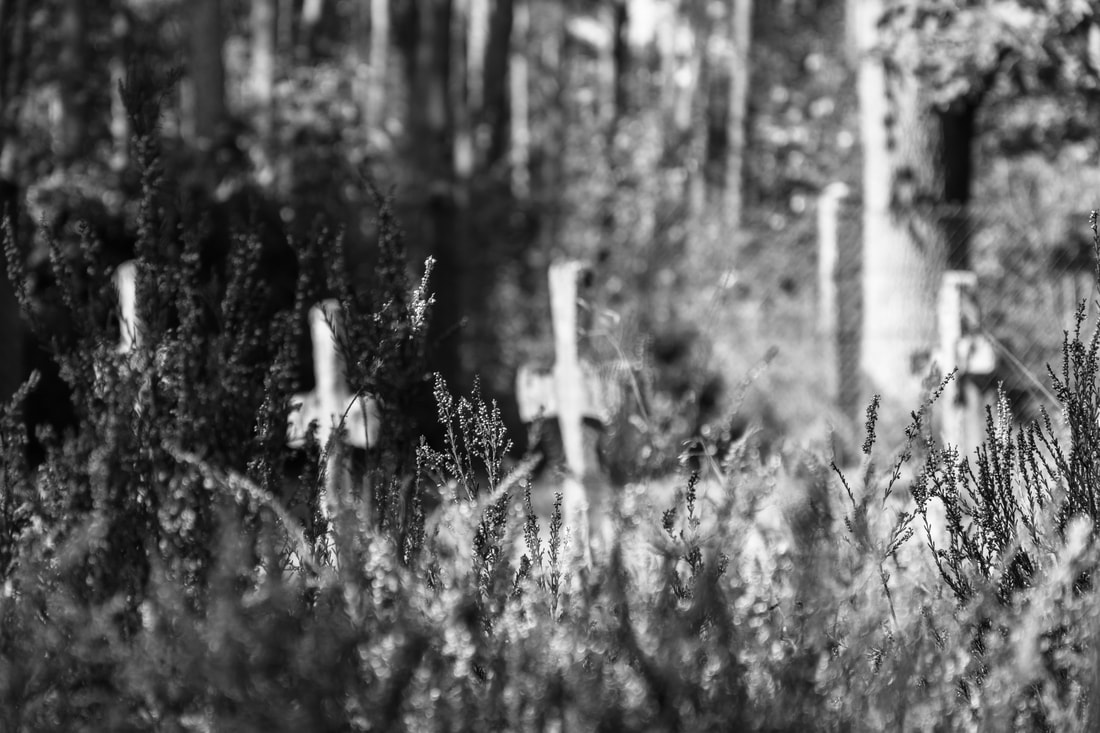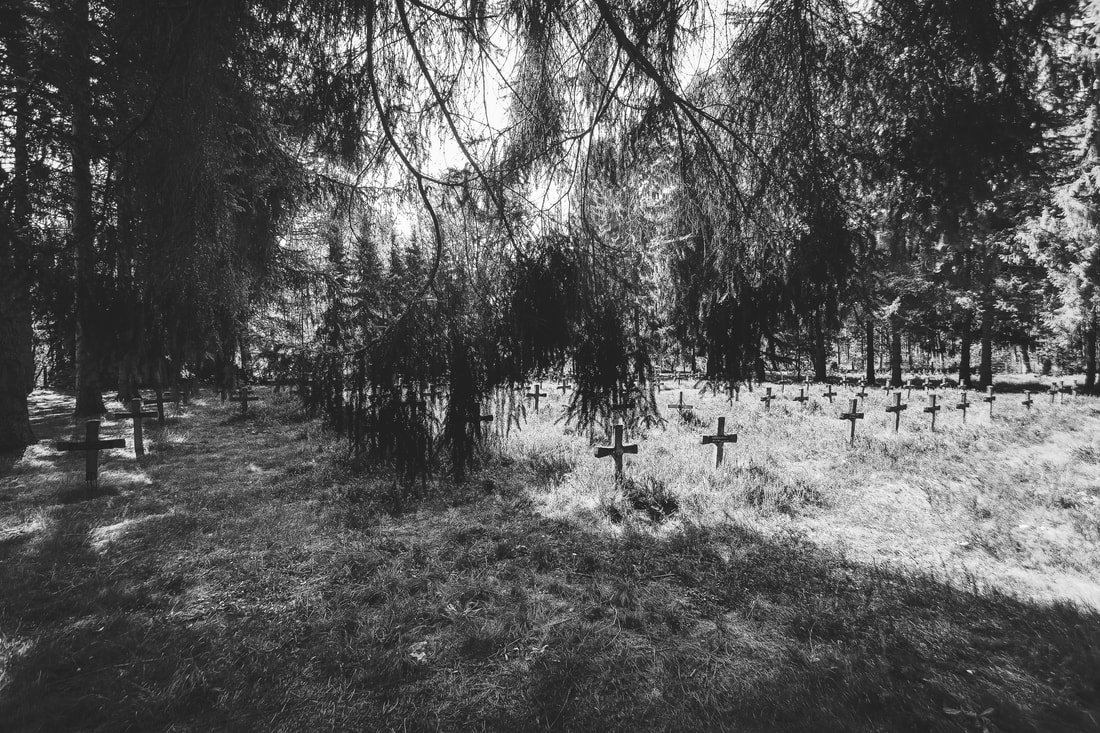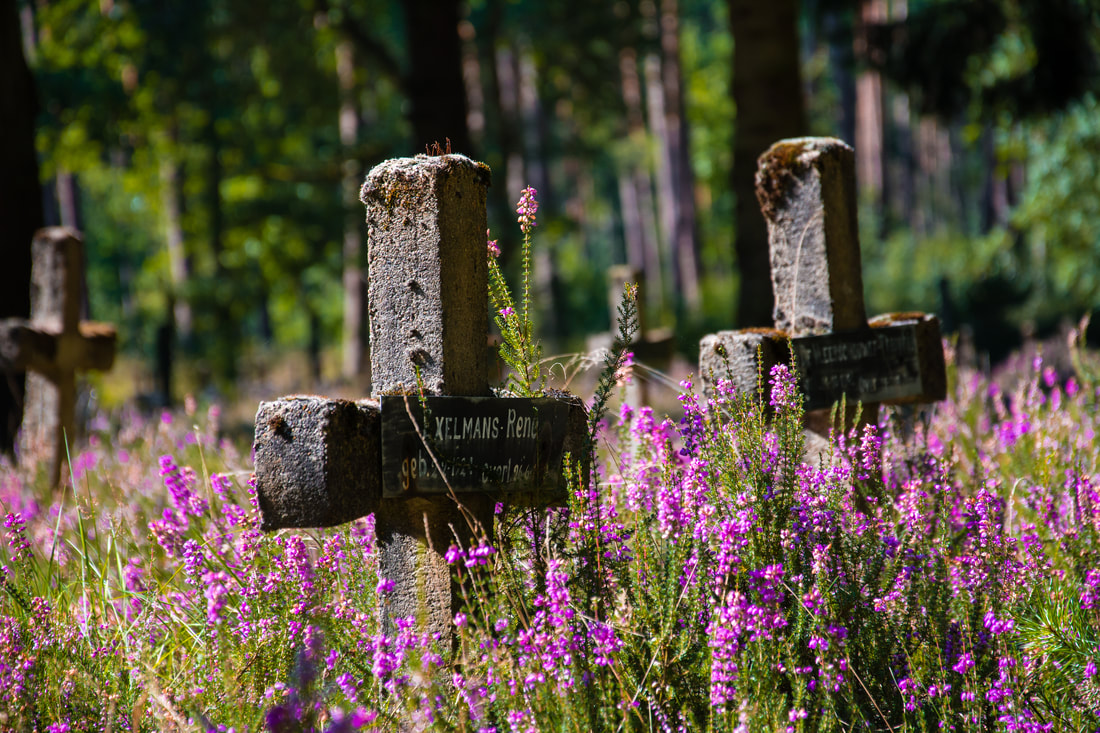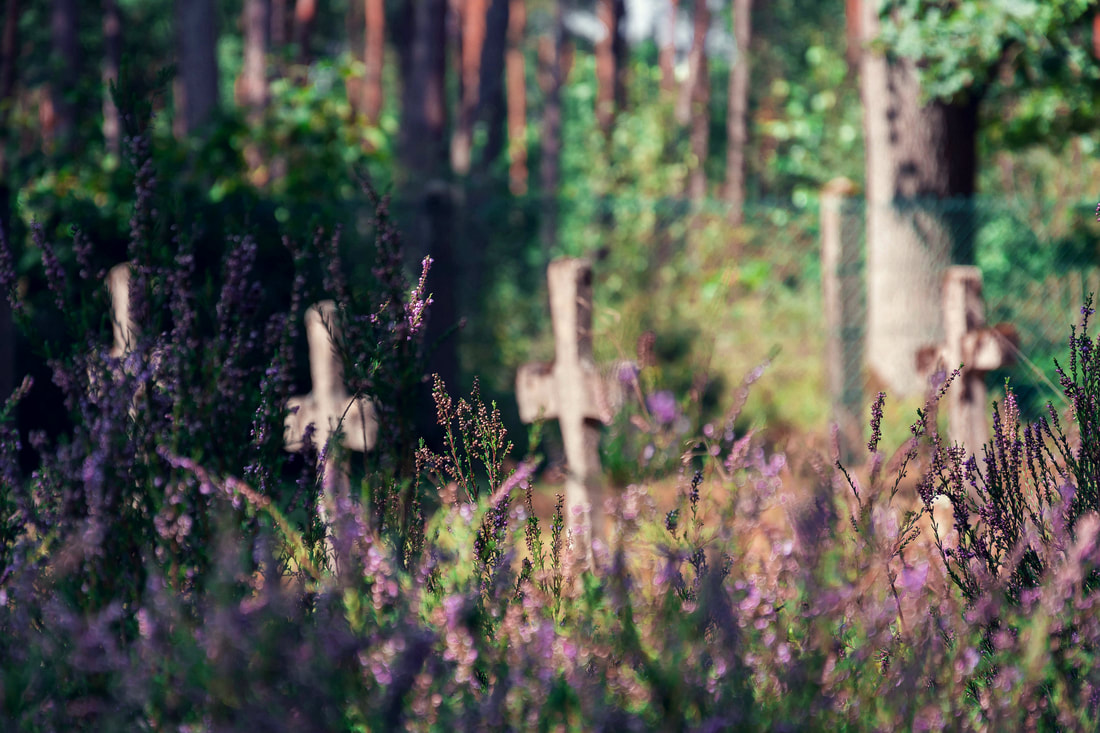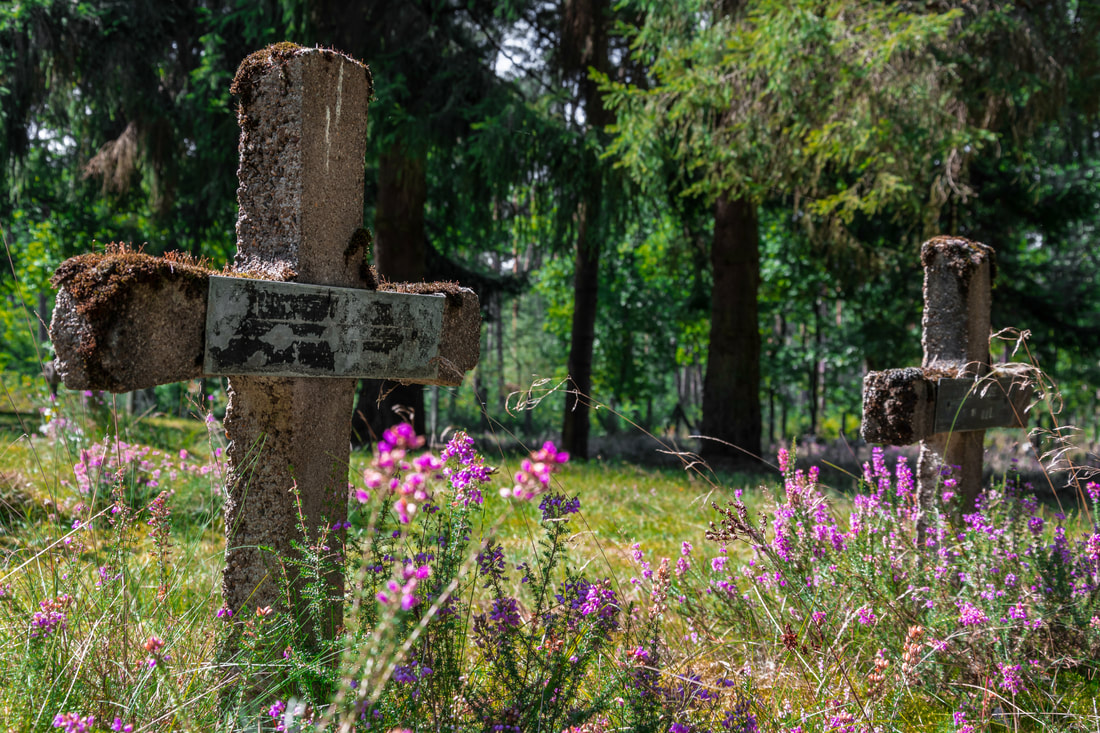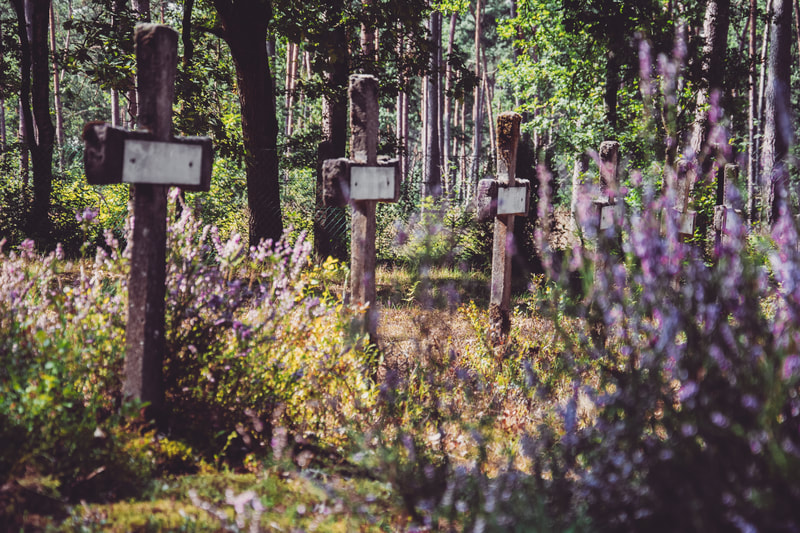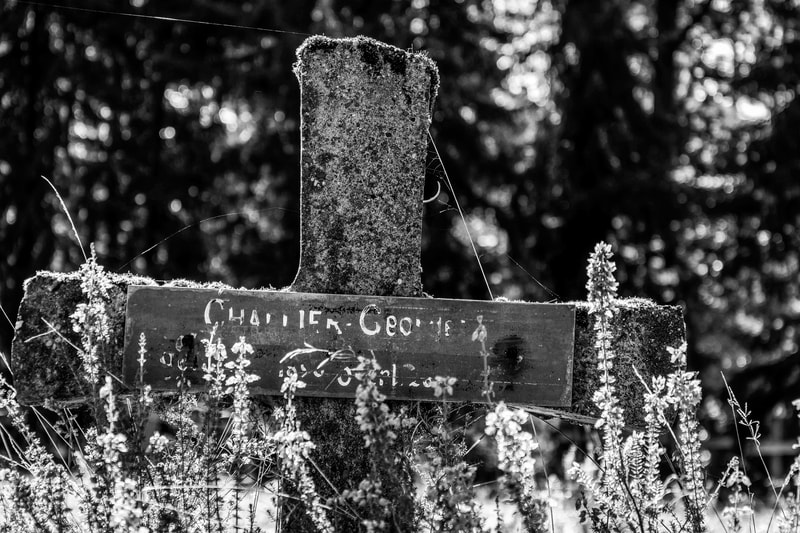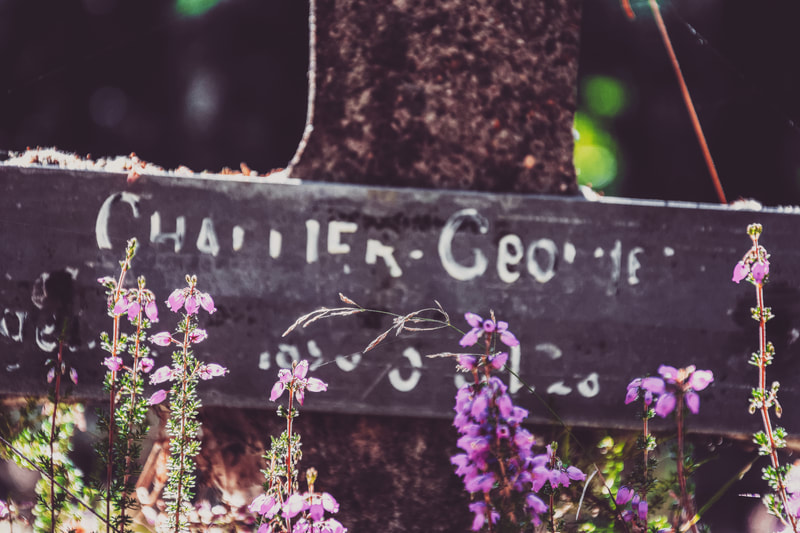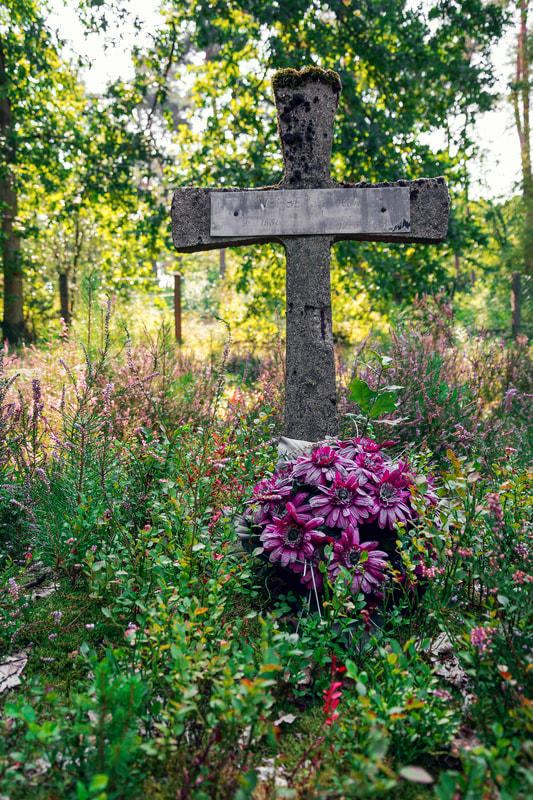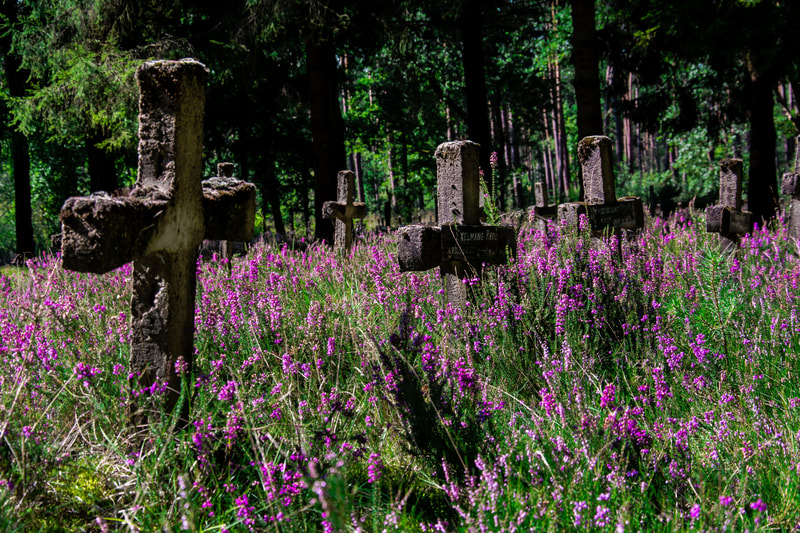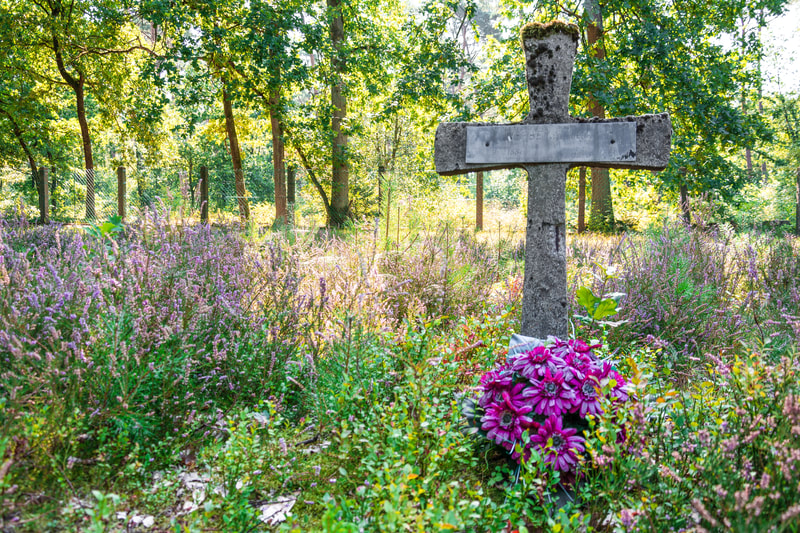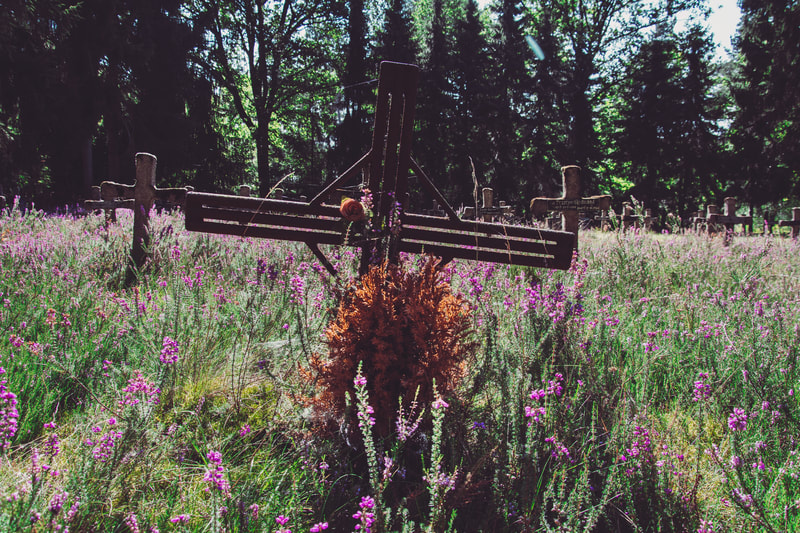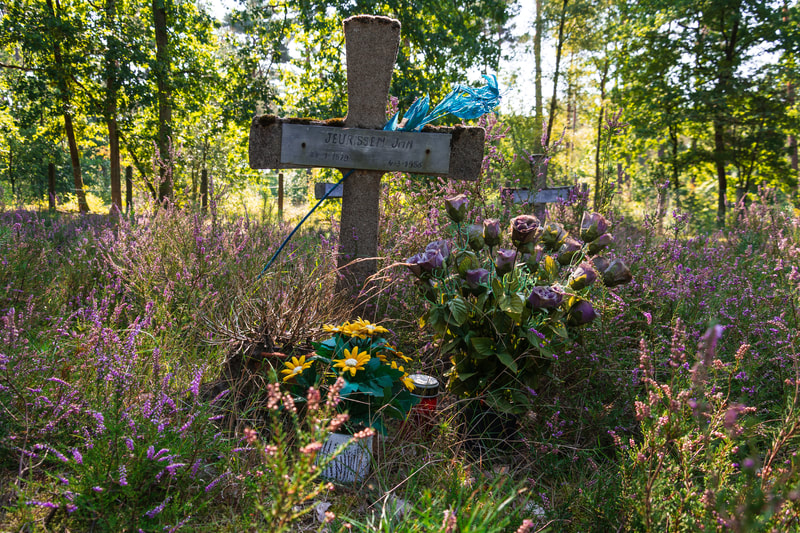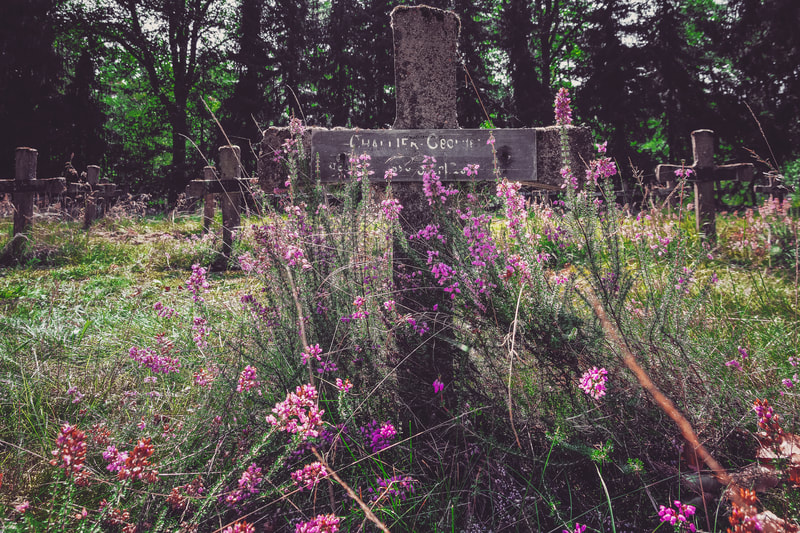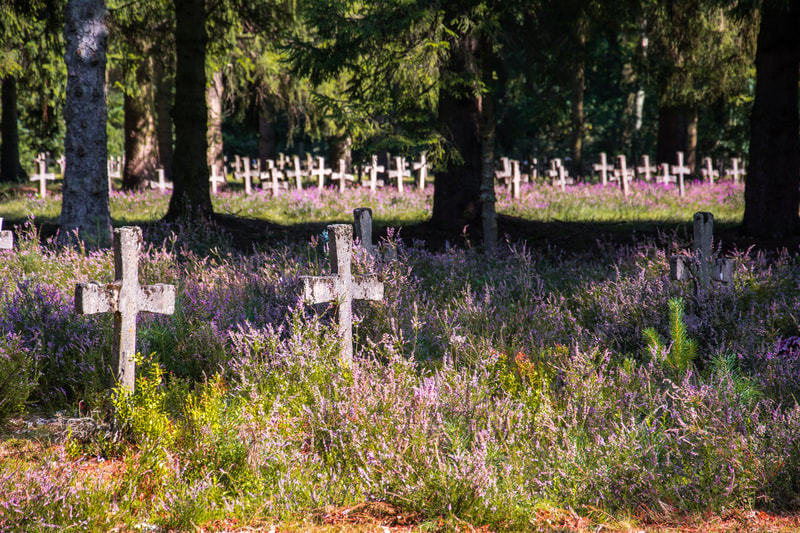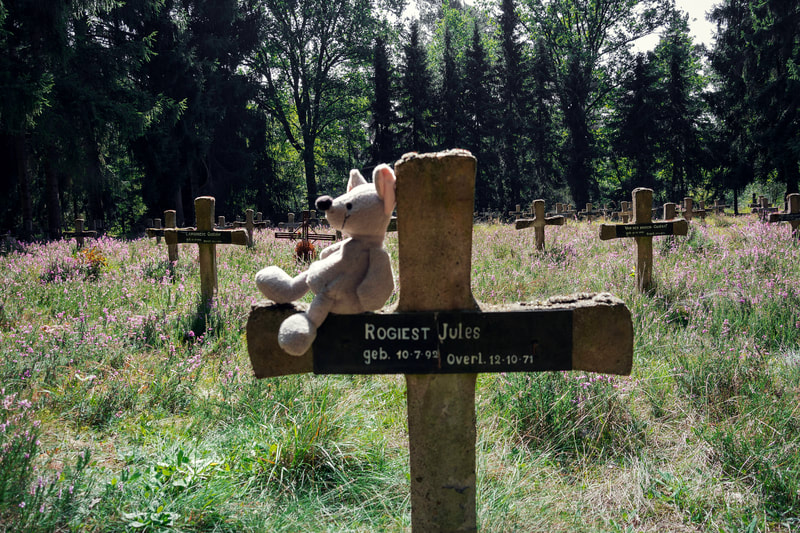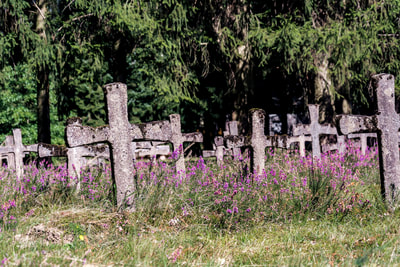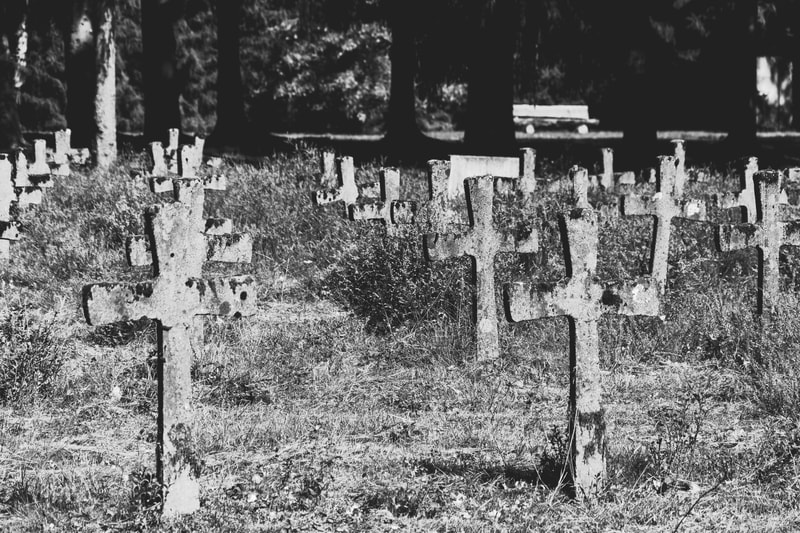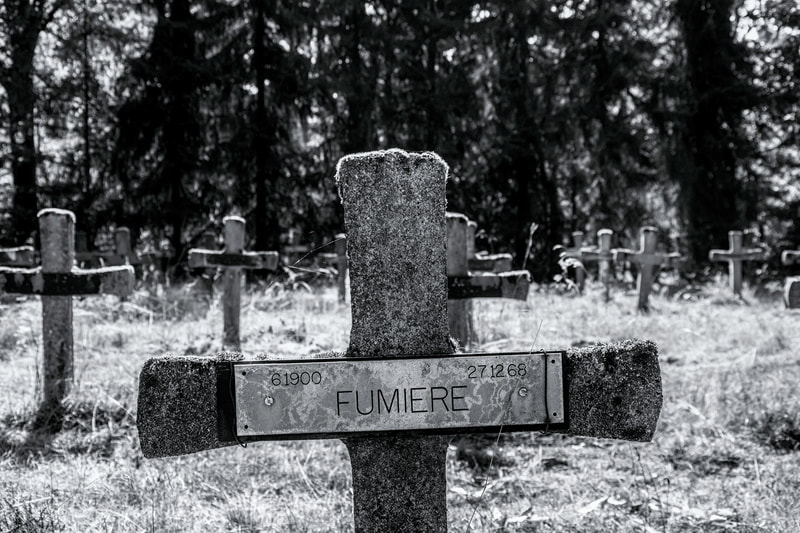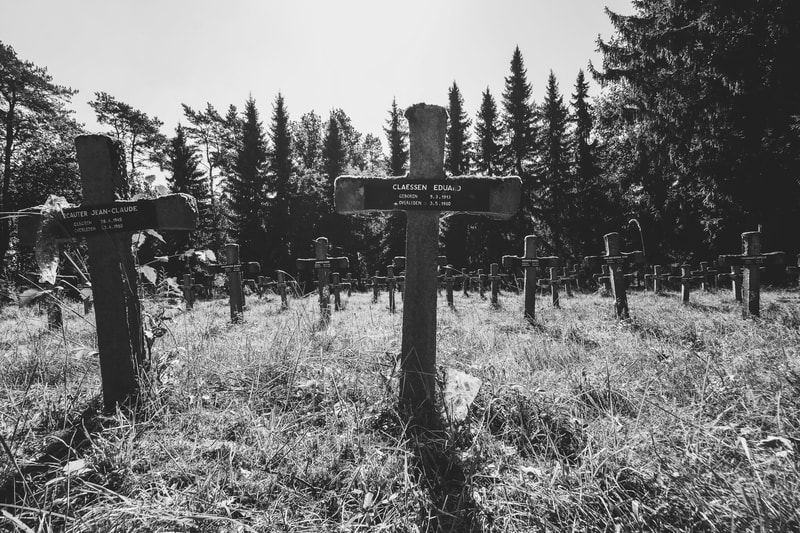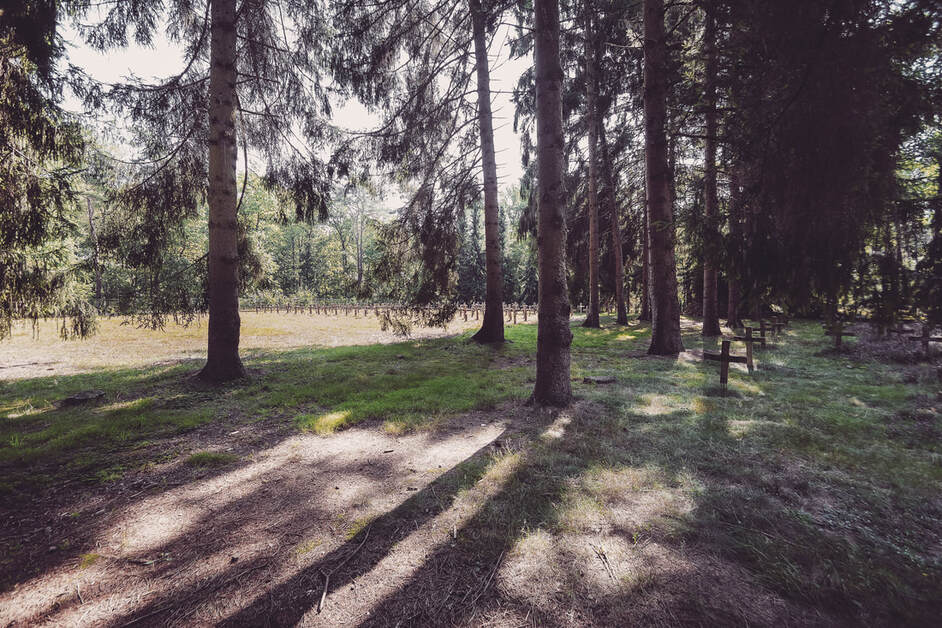Anstaltsfriedhof "Cemetery in the Woods"
"A child said to me What is the grass? fetching it to me with full hands; [...]
And now it seems to me the beautiful uncut hair of graves."
(Walt Whitman, "Song of Myself, 6)
And now it seems to me the beautiful uncut hair of graves."
(Walt Whitman, "Song of Myself, 6)
"High waving heather 'neath stormy blasts bending,
Midnight and moonlight and bright shining stars,
Darkness and glory rejoicingly blending,
Earth rising to heaven and heaven descending,
Man's spirit away from its drear dungeon sending,
Bursting the fetters and breaking the bars."
("High Waving Heather", Emily Brontë)
Midnight and moonlight and bright shining stars,
Darkness and glory rejoicingly blending,
Earth rising to heaven and heaven descending,
Man's spirit away from its drear dungeon sending,
Bursting the fetters and breaking the bars."
("High Waving Heather", Emily Brontë)
Eine ganz eigene Stille liegt über allem. Friedlich ist es hier. Heidekraut, zu einem Teppich zusammengewachsen, wuchert zwischen den verwitterten Kreuzen. Einst aus schmucklosem Stein gehauen, markieren sie hier die sterblichen Überreste eines Menschen, der in der nahe gelegenen psychiatrischen Klinik zwischen 1921 und 1981 verstorben war. Bei Gründung des Anstaltsfriedhofs im Jahr '21 trug das Krankenhaus noch die offizielle Bezeichnung, dem Jargon der Zeit geschuldet, "Rijkskrankzinnigengesticht" (zu deutsch etwa "staatliche Irrenanstalt"). Um die 1750, ausschließlich männliche, Patienten liegen hier begraben. Der letzte, wie bereits oben erwähnt, wurde im Jahr 1981 beigesetzt.
Die Gräber sind sehr schlicht gehalten. Die einzelnen Steinkreuze tragen lediglich kleine Metallplatten mit dem Namen, sowie dem Geburts- und Sterbedatum des jeweiligen Patienten. Man kommt nicht umhin, sich zu fragen, welche Schicksale hinter den Namen stecken mögen und wie viele letztlich, wie früher oft üblich, ihr gesamtes Leben in staatlicher Verwahrung verbringen mussten. Gemein haben sie jedenfalls alle, dass sie zumindest die letzte Zeit ihres Lebens dort verbringen mussten.
Die Grabstätte selbst liegt mitten im Wald versteckt und strahlte am Tag meines Besuchs eine mehr als friedliche Atmosphäre aus. Sicher war dies auch der Tatsache geschuldet, dass die Sonne unbarmherzig auf die Steinkreuze knallte und das Heidekraut dem Ganzen noch zusätzliche Farbe verlieh. Ein heißer Spätsommertag mag anders wirken, als beispielsweise ein kalter, nebliger Novembertag. Trotzdem hatte ich nicht das Gefühl, dass mich das Wetter an jenem Tag all zu sehr geblendet hatte. All die gleichförmigen, aneinandergereihten Kreuze, die verblichenen Plastikblumen und teils undefinierbare Gegenstände einer ganz eigenen Erinnerungskultur an den Kreuzen berühren doch ungemein.
Kurz vor dem Verlassen des Geländes erblicke ich eine wohl neu hinzugekommene Plüschmaus auf einem der Kreuze sitzend und doch bereits mit einer Spinnwebe am Kopf. Auch sie wirkt seltsam deplatziert. Mein Blick fällt gen Zaun, der den Friedhof umgibt. Eine Frau, mitten im Wald stehend, betrachtet mich, oder vielleicht auch lediglich das Areal an sich. Wie angewurzelt steht sie dort und in mir machten sich leise Zweifel breit, sie würde es vielleicht nicht gut heißen, mich auf dem Friedhofsgelände zu sehen. Doch als ich näher komme, kann ich erkennen, dass es sich um eine Patientin, der heute noch vorhanden Klinik handelt, die sich wohl bei einem Patientenausflug durch den Wald kurz abgesetzt hatte. Gerne hätte ich ihre Gedanken erfahren. Als ich mich dem Zaun nähere, verschwindet sie im Wald.
Die Gräber sind sehr schlicht gehalten. Die einzelnen Steinkreuze tragen lediglich kleine Metallplatten mit dem Namen, sowie dem Geburts- und Sterbedatum des jeweiligen Patienten. Man kommt nicht umhin, sich zu fragen, welche Schicksale hinter den Namen stecken mögen und wie viele letztlich, wie früher oft üblich, ihr gesamtes Leben in staatlicher Verwahrung verbringen mussten. Gemein haben sie jedenfalls alle, dass sie zumindest die letzte Zeit ihres Lebens dort verbringen mussten.
Die Grabstätte selbst liegt mitten im Wald versteckt und strahlte am Tag meines Besuchs eine mehr als friedliche Atmosphäre aus. Sicher war dies auch der Tatsache geschuldet, dass die Sonne unbarmherzig auf die Steinkreuze knallte und das Heidekraut dem Ganzen noch zusätzliche Farbe verlieh. Ein heißer Spätsommertag mag anders wirken, als beispielsweise ein kalter, nebliger Novembertag. Trotzdem hatte ich nicht das Gefühl, dass mich das Wetter an jenem Tag all zu sehr geblendet hatte. All die gleichförmigen, aneinandergereihten Kreuze, die verblichenen Plastikblumen und teils undefinierbare Gegenstände einer ganz eigenen Erinnerungskultur an den Kreuzen berühren doch ungemein.
Kurz vor dem Verlassen des Geländes erblicke ich eine wohl neu hinzugekommene Plüschmaus auf einem der Kreuze sitzend und doch bereits mit einer Spinnwebe am Kopf. Auch sie wirkt seltsam deplatziert. Mein Blick fällt gen Zaun, der den Friedhof umgibt. Eine Frau, mitten im Wald stehend, betrachtet mich, oder vielleicht auch lediglich das Areal an sich. Wie angewurzelt steht sie dort und in mir machten sich leise Zweifel breit, sie würde es vielleicht nicht gut heißen, mich auf dem Friedhofsgelände zu sehen. Doch als ich näher komme, kann ich erkennen, dass es sich um eine Patientin, der heute noch vorhanden Klinik handelt, die sich wohl bei einem Patientenausflug durch den Wald kurz abgesetzt hatte. Gerne hätte ich ihre Gedanken erfahren. Als ich mich dem Zaun nähere, verschwindet sie im Wald.
It´s a special kind of silence that´s being felt all over that place. It´s peaceful. Heather´s growing like a carpet and right between all the weathered stone crosses. Once made out of plain stone, they now mark the human remains of former patients of the nearby psychiatric hospital, who deceased between the years 1921 - 1981. As the cemetery was opened in '21 the hospital was still named "Rijkskrankzinnigengesticht" ("public mental hospital") - a customary term at that time. Around 1750 - exclusively male - patients were buried here. As mentioned above, the last one in 1981.
The graves are designed in a very simple manner. The individual stone cross only contains a metal plate with the name as well as the date of birth and death of the patient in question. You can´t help it but ask yourself what kind of lives they might had had. It was not uncommon that patients had to spend a significant part of their lives in such institutions, not to say even their whole lives. One thing is certain at last. They all had to spend the rest of their lives within an institution, which excluded them from society.
The graveyard itself is located right in the middle of the woods. Thanks to the sunny weather of a late summer´s day, it helped to find the atmosphere more peaceful than anything else. The sun was shining and created an immense heat between the stone crosses and the heather growing all over the place, just helped to add friendliness to the whole scenery. I´m sure a cold, misty November´s day would change the whole atmosphere completely. Yet, the friendly weather that day couldn´t delude me from that gloomy mood arising from deep down. All those seemingly perfect stone crosses in a row, those bleached out plastic flowers on some of the graves and further, partly indefinable objects being found on the site - remnants of an unique culture of memory - made me feel quite uneasy.
Shortly before leaving the grounds, I spotted a pretty new-looking plushie, a mouse. Sitting right on one of the crosses, already with cobwebs on its head. It really appeared out of place. My gaze settled on the fence around the burial site. Right in the middle of the woods, I could see a woman standing on the other side of the fence. Rooted at the spot and gazing back at me. Or maybe she wasn´t even looking at me, but the whole scenery itself. I started to feel a bit uneasy, as I feared she wouldn´t like me to be right in the middle of that burial site. Yet, when I started to approach her, I was able to recognize her as a patient of the still existing psychiatric hospital nearby. Apparently, she was on an excursion through the woods with other patients, but had left the group for a short time. I really asked myself, what her thoughts were. I´ll never know. Coming nearer, she disappeared in the thicket and I left the cemetery grounds.
The graves are designed in a very simple manner. The individual stone cross only contains a metal plate with the name as well as the date of birth and death of the patient in question. You can´t help it but ask yourself what kind of lives they might had had. It was not uncommon that patients had to spend a significant part of their lives in such institutions, not to say even their whole lives. One thing is certain at last. They all had to spend the rest of their lives within an institution, which excluded them from society.
The graveyard itself is located right in the middle of the woods. Thanks to the sunny weather of a late summer´s day, it helped to find the atmosphere more peaceful than anything else. The sun was shining and created an immense heat between the stone crosses and the heather growing all over the place, just helped to add friendliness to the whole scenery. I´m sure a cold, misty November´s day would change the whole atmosphere completely. Yet, the friendly weather that day couldn´t delude me from that gloomy mood arising from deep down. All those seemingly perfect stone crosses in a row, those bleached out plastic flowers on some of the graves and further, partly indefinable objects being found on the site - remnants of an unique culture of memory - made me feel quite uneasy.
Shortly before leaving the grounds, I spotted a pretty new-looking plushie, a mouse. Sitting right on one of the crosses, already with cobwebs on its head. It really appeared out of place. My gaze settled on the fence around the burial site. Right in the middle of the woods, I could see a woman standing on the other side of the fence. Rooted at the spot and gazing back at me. Or maybe she wasn´t even looking at me, but the whole scenery itself. I started to feel a bit uneasy, as I feared she wouldn´t like me to be right in the middle of that burial site. Yet, when I started to approach her, I was able to recognize her as a patient of the still existing psychiatric hospital nearby. Apparently, she was on an excursion through the woods with other patients, but had left the group for a short time. I really asked myself, what her thoughts were. I´ll never know. Coming nearer, she disappeared in the thicket and I left the cemetery grounds.
